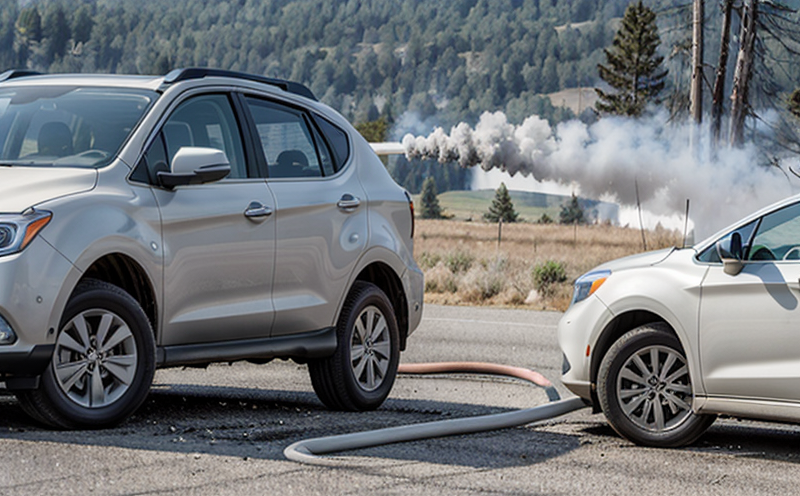Laboratory Documentation of Smoke and Toxic Gas Testing
In the realm of fire safety testing, ensuring that materials, products, and systems comply with stringent smoke density and toxic gas emission standards is paramount. This service ensures comprehensive laboratory documentation for these parameters, providing assurance that products meet regulatory requirements and enhance public safety.
The process begins with careful specimen preparation, where samples are cut to specific dimensions as per relevant international standards such as ISO 56601 or ASTM E2387. The testing apparatus used includes sophisticated gas analyzers capable of detecting minute quantities of toxic gases like carbon monoxide (CO), hydrogen cyanide (HCN), and others. These instruments provide precise measurements that are critical for understanding the emissions during a fire event.
The testing methodology involves subjecting the specimens to controlled combustion, typically in an oxygen-controlled environment to simulate real-world conditions. The smoke density is measured using light scattering techniques, while toxic gas concentrations are quantified through chemiluminescence and infrared spectroscopy among other methods. This approach ensures accurate data that can be relied upon for compliance purposes.
Once the tests are completed, detailed reports are generated, which include not only the raw numerical results but also graphical representations of the emissions over time. These reports serve as crucial documentation for regulatory bodies and internal quality control processes. Compliance officers can use these documents to verify that products meet stringent safety standards such as EN 13501-1 or NFPA 285.
The importance of this service extends beyond mere compliance; it plays a vital role in product development by providing insights into material choices and design optimizations. R&D engineers can leverage the data to improve formulas, reduce harmful emissions, and enhance overall safety performance. The rigor of these tests ensures that the products not only meet regulatory requirements but also contribute positively to public health and safety.
| Parameter | Measurement Method | Acceptance Criteria |
|---|---|---|
| Smoke Density (Optical Smoke Opacity) | Light Scattering Technique | <10% according to ISO 56601-2 |
| Toxic Gas Emissions (CO, HCN) | CHEMILUMINESCENCE and INFRARED SPECTROSCOPY | <10 ppm according to EN 395 |
The meticulous nature of this testing ensures that products can be marketed with confidence, knowing they meet the highest standards of safety and compliance. This service is not just a compliance measure but an integral part of product development and quality assurance.
Eurolab Advantages
EuroLab stands out in the field of fire safety testing, offering unparalleled expertise and state-of-the-art facilities. Our dedicated team of engineers and scientists leverages advanced technology to provide accurate and reliable data for smoke density and toxic gas emission testing.
We offer a range of benefits that set us apart from our competitors:
- Comprehensive Testing Capabilities: We can test various materials, products, and systems under controlled conditions to ensure compliance with international standards.
- Expertise and Experience: Our team has extensive experience in fire safety testing, ensuring that we stay at the forefront of industry best practices.
- Accurate Reporting: Detailed reports are generated for each test, providing a comprehensive overview of the results. This transparency enhances trust with our clients.
- Timely Delivery: We understand the importance of timely results and strive to provide them without compromising on accuracy or quality.
In addition to these advantages, EuroLab’s commitment to innovation ensures that we are always adapting to new standards and technologies in fire safety testing. This continuous improvement process guarantees that our clients receive the most accurate and up-to-date information possible.
Why Choose This Test
The decision to conduct smoke density and toxic gas emission tests is crucial for several reasons. Primarily, it ensures that products meet stringent safety standards, which is essential in preventing fires and minimizing their impact should one occur.
By conducting these tests, manufacturers can identify potential hazards early on in the product development process. This proactive approach allows them to make necessary adjustments and improvements before a product reaches the market. In addition to enhancing public safety, this practice also helps avoid costly recalls and legal issues down the line.
The testing process also aids in regulatory compliance. Many regions have specific regulations governing the smoke density and toxic gas emissions of certain products. By undergoing these tests, manufacturers demonstrate their commitment to adhering to local laws and regulations. This can enhance a company’s reputation and build trust with consumers who value safety and quality.
Moreover, the results from these tests provide valuable insights into product performance under fire conditions. This information is invaluable for R&D teams as they strive to improve their products continuously. The data obtained during testing can lead to innovations that not only meet but exceed current standards, positioning a company at the forefront of technology and safety.
In conclusion, choosing this test is an investment in both public safety and product quality. It ensures compliance with regulations while fostering innovation and continuous improvement within the industry.
Use Cases and Application Examples
| Application Example | Description |
|---|---|
| Building Materials | Evaluating the smoke and toxic gas emissions of insulation materials to ensure they meet fire safety standards. |
| Furniture and Upholstery | Determining the impact of different fabrics on smoke density and toxic gas release during a fire event. |
| Electrical Appliances | Assessing the emissions from electrical devices to ensure they do not contribute significantly to indoor pollution in case of a fire. |
| Fabric and Textiles | Evaluating the safety of textiles used in clothing or home decor, ensuring they comply with relevant regulations. |
| Automotive Components | Determining the emissions from vehicle parts to ensure they are safe during a fire scenario inside a vehicle. |
| Building Insulation | Evaluating insulation materials used in construction projects for their smoke and toxic gas characteristics. |





